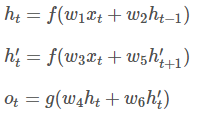07.TensorFlow双向循环神经网络
鉴于单向循环神经网络某些情况下的不足,提出了双向循环神经网络。因为是需要能关联未来的数据,而单向循环神经网络属于关联历史数据,所以对于未来数据提出反向循环神经网络,两个方向的网络结合到一起就能关联历史与未来了。
双向循环神经网络按时刻展开的结构如下,可以看到向前和向后层共同连接着输出层,其中包含了6个共享权值,分别为输入到向前层和向后层两个权值、向前层和向后层各自隐含层到隐含层的权值、向前层和向后层各自隐含层到输出层的权值。

可以由下列式子表示

实现代码:
""" # @Time : 2021/3/4 10:18 # @Author : cuixingyu # @File : Test07.py # @Software: PyCharm """ from __future__ import print_function #import tensorflow as tf import tensorflow.compat.v1 as tf tf.disable_v2_behavior() from tensorflow.python.ops import rnn #from tensorflow.contrib import rnn from tensorflow.examples.tutorials.mnist import input_data import os os.environ["CUDA_VISIBLE_DEVICES"]="0" mnist=input_data.read_data_sets("MNIST_data",one_hot=True) #Traning Parameters learning_rate=0.001 training_step=10000 batch_size=128 display_step=400 #Network Parmeters num_input=28 timestep=28 num_hidden=128 num_classes=10 #tf Graph input X=tf.placeholder("float32",[None,timestep,num_input]) Y=tf.placeholder("float32",[None,num_classes]) #Define weights weights={ 'out':tf.Variable(tf.random_normal([2*num_hidden,num_classes])) } biases={ 'out':tf.Variable(tf.random_normal([num_classes])) } def BiRNN(X,weights,biases): x=tf.unstack(X,timestep,1) #define lstm cells with tensorflow #Forward direction cell lstm_fw_cell=tf.nn.rnn_cell.BasicLSTMCell(num_hidden, forget_bias=1.0) #lstm_fw_cell=rnn.BasicLSTMCell(num_hidden,forget_bias=1.0) #Backward direction cell lstm_bw_cell=tf.nn.rnn_cell.BasicLSTMCell(num_hidden, forget_bias=1.0) #Get lstm cell output try: outputs,_,_=rnn.static_bidirectional_rnn(lstm_fw_cell,lstm_bw_cell,x,dtype=tf.float32) except Exception: outputs=rnn.static_bidirectional_rnn(lstm_fw_cell,lstm_bw_cell,x,dtype=tf.float32) # Linaer activation,using rnn inner loop last output return tf.matmul(outputs[-1],weights['out'])+biases['out'] logits=BiRNN(X,weights,biases) prediction=tf.nn.softmax(logits) #Define loss and optimizer loss_op=tf.reduce_mean(tf.nn.softmax_cross_entropy_with_logits(logits=logits,labels=Y)) optimizer=tf.train.GradientDescentOptimizer(learning_rate=learning_rate) train_op=optimizer.minimize(loss_op) #Evaluate model correct_pred=tf.equal(tf.argmax(prediction,1),tf.argmax(Y,1)) accuracy=tf.reduce_mean(tf.cast(correct_pred,tf.float32)) #Initialize Variable init=tf.global_variables_initializer() #start training with tf.Session() as sess: # Run the initializer sess.run(init) for step in range(1,training_step+1): batch_x,batch_y=mnist.train.next_batch(batch_size) #Reshape data to get 28 seq of 28 elements batch_x=batch_x.reshape((batch_size,timestep,num_input)) # Run optimizetion op sess.run(train_op,feed_dict={X:batch_x,Y:batch_y}) if step % display_step == 0 or step==1: loss,acc=sess.run([loss_op,accuracy],feed_dict={X:batch_x,Y:batch_y}) print("Step "+str(step)+ ",Minbatch Loss="+"{:.4f}".format(loss)+",Training Accuracy="+"{:.3f}".format(acc)) print("Optimization Finished!") #Calculate accuracy for 128 mnist test images test_len=128 test_data=mnist.test.images[:test_len].reshape((-1,timestep,num_input)) test_label=mnist.test.labels[:test_len] print("Test Accuracy:",sess.run(accuracy,feed_dict={X:test_data,Y:test_label}))
运行结果:



